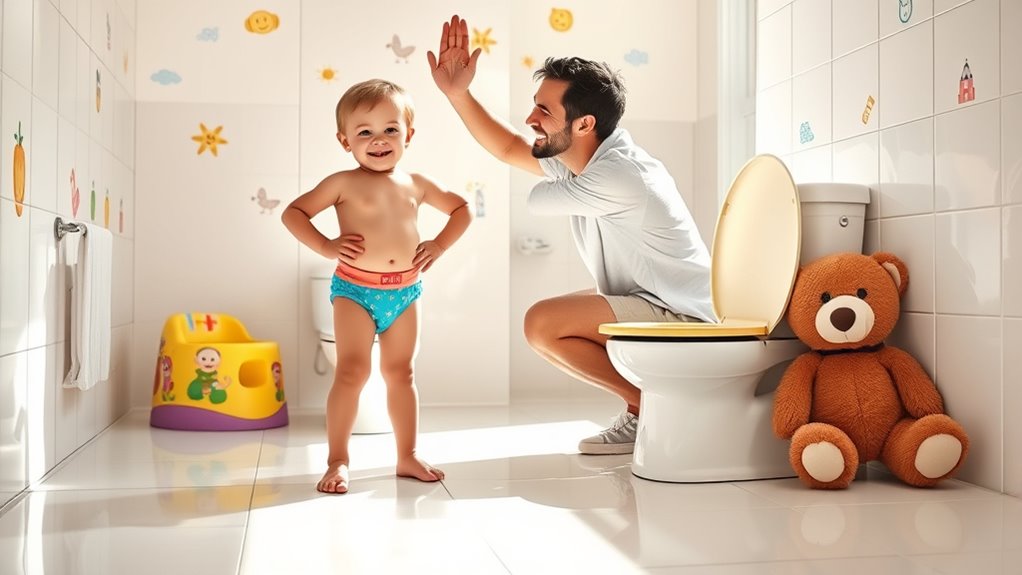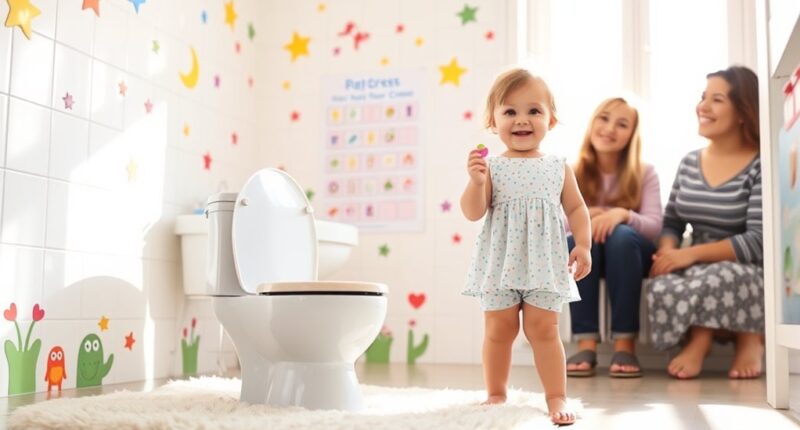One quick potty training tip that works is to establish a consistent routine. Take your child to the potty after meals, naps, and before bedtime. This regular schedule helps them understand when to go and builds their confidence. You can also motivate them with small rewards like stickers or treats for their successes. Remember, accidents are normal, so stay calm and supportive. Want to discover more effective strategies for a smoother change?
Key Takeaways
- Ensure your child shows readiness signs, such as interest in the potty and staying dry for longer periods.
- Establish a consistent potty routine by scheduling visits after meals, naps, and before bedtime.
- Motivate your child with immediate rewards like stickers or praise for successful potty use.
- Involve your child in the process by letting them choose their own potty and fun underwear.
- Stay calm and supportive during accidents, reassuring them that mistakes are part of the learning process.

Potty training can feel like a challenging task for many parents, but with the right approach, you can make the process smoother and more enjoyable for both you and your child. One of the most important potty training tips is recognizing the signs of readiness in your little one. Look for behaviors such as showing interest in the potty, staying dry for longer periods, or expressing discomfort with dirty diapers. Starting the potty training process when your child is ready can greatly ease the change and is similar to the importance of clear communication during emotional transitions. In fact, understanding the role of digital literacy programs can further enhance the learning experience for both parents and children. Additionally, maintaining a consistent routine helps to mimic the potty training techniques that have been proven effective in various parenting resources.
Once you’ve noted those readiness signs, it’s time to establish a consistent routine. Create a regular potty schedule by encouraging bathroom visits after meals, naps, and before bedtime. This helps reinforce the habit and builds confidence in your child. Consistency is key, and your little one will begin to understand when it’s time to use the potty, making the process more predictable and less stressful.
Establishing a consistent potty schedule helps reinforce good habits and builds your child’s confidence in using the potty.
Another effective strategy is to motivate your child with immediate rewards. Many parents find that offering small treats, stickers, or praise right after a successful potty visit can lead to quicker success rates than waiting for long-term incentives. This instant gratification can boost your child’s enthusiasm and encourage them to keep using the potty.
Involving your child in choices can also make a big difference. Let them pick out their own potty or fun underwear. This sense of ownership can foster excitement about the potty training process, increasing their willingness to participate. When children feel like they’ve a say in their training, they’re more likely to engage positively with it.
Don’t forget to prepare for accidents. They’re a normal part of the learning process, and it’s essential to maintain a calm demeanor when they occur. Reassure your child that it’s okay and that they’re still learning. Your support during these moments can help them feel secure and encourage them to keep trying. Additionally, understanding that emotional turmoil may arise during this time can help parents navigate their child’s feelings and reactions effectively.
Frequently Asked Questions
What Is the Fastest Way to Potty Train?
The fastest way to potty train is by using a focused approach like the three-day method.
You’ll want to go diaper-free at home for those three days, allowing your child to recognize their cues. Start when they’re between 18 to 36 months for the best results.
Consistency is essential, so establish a routine and offer immediate rewards like stickers to keep them motivated.
What Is the 10 Minute Rule for Potty Training?
Imagine a clock ticking steadily, each tick a reminder for your little one to embrace a new habit.
The 10 Minute Rule for potty training means you take your child to the potty every ten minutes during those essential early days. This regularity helps them recognize their body’s signals while reducing accidents.
As they gain confidence, you can stretch the intervals, creating a stress-free environment for both of you. Consistency and encouragement work wonders!
What Is the 3 Day Potty Training Trick?
The 3-Day Potty Training Trick is an intensive method where you keep your child at home for three days, letting them go without diapers and pants.
On Day One, you’ll encourage them to use the potty frequently, watching for cues.
Day Two continues this routine, adding small rewards for successes.
What Are the Three C’s of Potty Training?
You might think potty training’s all about quick fixes, but it’s really about the Three C’s: Consistency, Communication, and Comfort.
You’ll want to establish a routine for when your child uses the potty, using the same phrases to reinforce the process.
Discuss the experience openly with your child, and make sure the potty is comfortable and accessible.
This way, you’re creating a supportive environment that reduces stress for both of you.
Conclusion
In the grand adventure of potty training, remember that every little victory is a step closer to the finish line. Celebrate those successes like fireworks lighting up the night sky! It’s all about patience and encouragement, so keep the atmosphere light and playful. With a sprinkle of consistency and a dash of humor, you’ll turn this challenge into a delightful journey. Soon, you’ll be cheering as your little one conquers the potty like a true champion!









